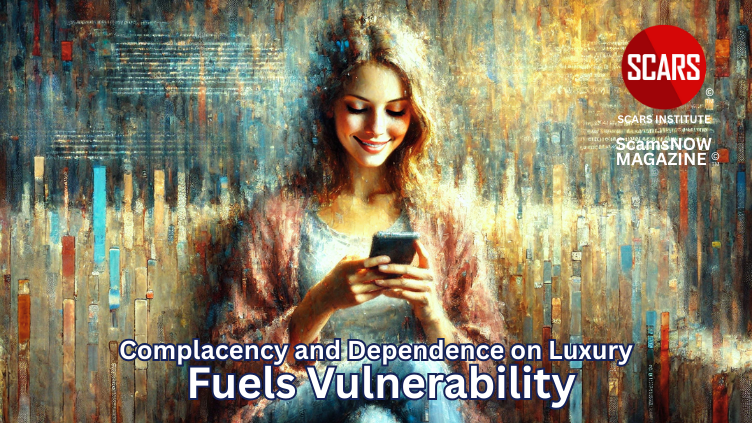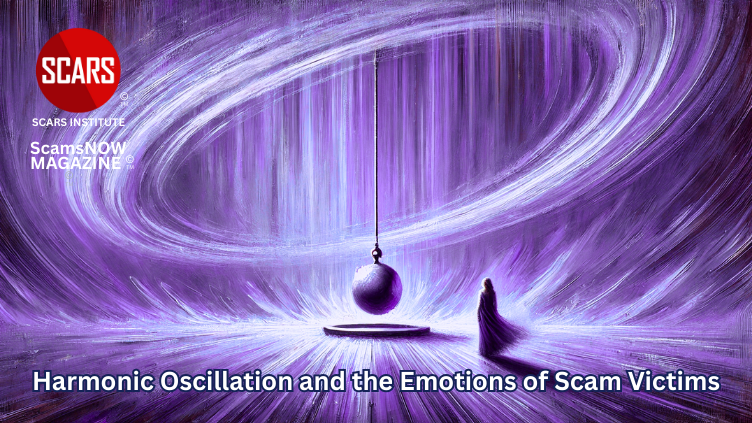Harmonic Oscillation and the Emotions of Scam Victims
A Journey Through Emotional Extremes
Primary Category: Scam Victim Recovery Psychology
Intended Audience: Scam Victims-Survivors / Family & Friends
Author:
• Tim McGuinness, Ph.D., DFin, MCPO, MAnth – Anthropologist, Scientist, Polymath, Director of the Society of Citizens Against Relationship Scams Inc.
About This Article
The emotional aftermath of a scam is not linear—it unfolds in waves, cycling between extremes like shock, despair, anger, and shame. These internal swings mirror the physical concept of harmonic oscillation, where a system moves back and forth between opposing states before gradually coming to rest. Just as friction and resistance slow a swinging pendulum, emotional damping occurs through time, support, self-awareness, and therapeutic care. Triggers can reignite the cycle, but recognizing them—and responding with clarity instead of panic—helps reduce their impact.
Recovery is not about erasing the experience, but about moving toward a steady internal rhythm where emotions no longer dominate or define you. As scam victims learn to observe their own responses, reconnect with others, and rebuild their sense of agency, the pendulum begins to slow. Eventually, emotional equilibrium becomes possible—not as a return to the past, but as a grounded new beginning rooted in resilience, awareness, and peace.

Harmonic Oscillation in Scam Victims: A Journey Through Emotional Extremes
Harmonic Oscillation – Every now and then, we come across aspects of the world that resonate with the experience of scam victims and the way we share information with them. This is one of those cases where it make no sense at first until you explore it just a bit futher.
In this case, we are going to combine physics, calculus, trigonometry, AND your emotions! How is that possible? You will see…
What is Harmonic Oscillation?
Harmonic oscillation refers to a type of repetitive, back-and-forth motion where the restoring force is directly proportional to the displacement from an equilibrium position. It’s often described in systems like springs, pendulums, or even electrical circuits.
In simple terms:
It’s when something moves back and forth in a smooth, regular pattern—like a child on a swing, a mass bouncing on a spring, or voltage in an AC circuit.
The most basic form is simple harmonic motion (SHM), which follows this formula:
F = -kx
Where:
-
-
-
F is the restoring force
-
k is a constant specific to the system
-
x is the displacement from equilibrium
-
The negative sign means the force always acts to bring the object back to center
-
-
Examples include:
-
-
-
A weight on a spring
-
A pendulum swinging (approximately)
-
Vibrating guitar strings
-
-
![Simple-Harmonic-Motion[1] Harmonic Oscillation and the Emotions of Scam Victims - 2025](https://scamsnow.com/wp-content/uploads/2025/03/Simple-Harmonic-Motion1.jpg)
![oscillations[1] Harmonic Oscillation and the Emotions of Scam Victims - 2025](https://scamsnow.com/wp-content/uploads/2025/03/oscillations1.jpg)
Look at those Two Diagrams
What do you notice about those two diagrams? What is the difference?
Now Think About Your Emotions After the Scam
The aftermath of falling victim to a scam often plunges individuals into a tumultuous emotional journey, oscillating between extremes such as profound sadness and intense anger. This cyclical pattern mirrors the physical concept of harmonic oscillation, where a system swings between two opposing states, gradually decreasing in intensity over time due to damping effects. In your case, the dampening effect is the process of recovery.
Understanding this analogy provides insight into the psychological experiences of scam victims and offers pathways toward healing and equilibrium.
Understanding Harmonic Oscillation
In physics, harmonic oscillation describes a system that moves back and forth between two positions in a regular, repeating pattern. Examples include a pendulum’s swing or a mass bobbing on a spring. Over time, external forces like friction cause these movements to diminish—a phenomenon known as damping—until the system eventually comes to rest.
Harmonic oscillation, in its most basic form, refers to the repeated movement of a system between two opposing extremes. It is a central concept in physics, often illustrated by a pendulum swinging back and forth under the influence of gravity, or by a spring compressing and expanding in a regular rhythm. These systems operate within predictable boundaries and tend to return toward a central resting point after being displaced. The further the object moves from its equilibrium, the stronger the force pulling it back—yet that same force carries it past the center in the opposite direction. This creates an ongoing rhythm of movement, one direction fueling the next.
Over time, however, this movement doesn’t continue indefinitely. Real-world systems are subject to forces like friction, resistance, or air drag—forces that gradually rob the system of its energy. This effect is called damping. As damping takes hold, the oscillations begin to shrink. The swings become smaller, less intense, and eventually, the system settles at rest. This transition from extreme motion to stillness is a useful metaphor for many emotional and psychological processes, particularly the one scam victims face in the aftermath of betrayal.
Emotional Oscillation in Scam Victims
Overview
Similarly, individuals who have been scammed often experience emotional oscillations between opposing feelings:
Initial Shock and Denial: Upon realizing they’ve been deceived, victims may feel numbness and disbelief, struggling to accept the reality of the situation.
Profound Sadness and Despair: As the truth sinks in, deep sorrow emerges, accompanied by feelings of loss—not only of finances but also of trust and self-esteem.
Intense Anger and Resentment: Sadness often gives way to anger directed at the scammer, oneself, or institutions perceived as failing to prevent the fraud.
These emotions can cycle repeatedly, creating an internal struggle that mirrors the back-and-forth motion of harmonic oscillation.
In-Depth
Emotional Oscillation in Scam Victims
Much like physical systems, the emotional lives of scam victims often enter a state of oscillation after the scam is discovered. This is not a calm or linear path toward healing. Instead, it is a volatile cycle—an emotional pendulum swinging between states of grief, anger, confusion, self-blame, and despair. Each feeling has a gravitational pull of its own, and in the early stages, the intensity can be overwhelming.
Initial Shock and Denial
When the reality of the scam begins to surface, the first reaction is often shock. Victims may feel disconnected from what they’re seeing or hearing. Their thoughts slow, their senses dull, and they begin asking questions like, “Could this really be happening?” or “There must be some mistake.” This is the moment the pendulum has been pulled far from center and is hanging in suspension—energy building, but not yet moving.
Denial is a natural part of this initial phase. It acts as a psychological buffer, protecting the mind from the full force of the emotional blow. Victims may cling to any remaining doubt about the scammer’s guilt or look for alternative explanations. This moment of paralysis can last minutes, hours, or days. But eventually, gravity takes hold, and the mind starts moving toward confrontation with reality.
Profound Sadness and Despair
Once denial begins to dissolve, sadness rushes in to take its place. This is a drop into the opposite extreme—an emotional collapse under the weight of what has been lost. The sadness is not limited to financial impact. Scam victims mourn something far more personal: the loss of trust, the loss of perceived connection, and the collapse of a reality they had emotionally invested in.
This despair can feel bottomless. It may include crying spells, insomnia, withdrawal from others, and an overwhelming sense of helplessness. Victims often describe feeling like they’re watching their life unravel from a distance, powerless to stop it. In this phase, the pendulum has swung hard in the other direction, accelerating through the pain of realization.
Intense Anger and Resentment
Sadness rarely remains dominant for long. It often triggers anger—an equally powerful emotion but one that carries a different kind of energy. Here the pendulum swings once more, propelled by the natural psychological need to reclaim a sense of control. Anger gives victims a sense of agency, of being wronged rather than just foolish. It offers a target: the scammer, the platforms that enabled the scam, even friends or institutions that “should have warned” them.
In some cases, this anger is turned inward. Victims begin to rage at themselves for falling for the lie, for ignoring red flags, for trusting someone who never existed. This internalized anger is corrosive and can fuel shame, deepening the emotional toll and setting the stage for another swing back toward sadness.
The Loop Continues
These emotional states—shock, sadness, anger—rarely happen in a neat sequence. Instead, they cycle. One moment a victim may feel calm and grounded; the next, a song, a photo, or a text message memory can trigger another violent swing. The pendulum is in full motion now, back and forth across the emotional spectrum.
Each phase feeds the next. Sadness softens into regret. Regret sharpens into anger. Anger collapses into self-doubt. The pattern repeats—an exhausting psychological loop that makes it hard to trust oneself or believe that healing is even possible.
But just as in physical systems, these oscillations are not infinite. In the presence of supportive environments, therapeutic tools, and time, the emotional energy begins to dampen. The swings may continue, but with less force. The highs and lows lose their dominance. The pendulum, once wild and unpredictable, begins its gradual return toward emotional balance.
Damping: The Gradual Easing of Emotional Extremes
Just as physical systems eventually come to rest due to friction and resistance, the emotional turbulence scam victims endure also tends to ease over time. This process—psychological damping—is not immediate, nor is it uniform. It is a slow unwinding of intensity, a natural but uneven retreat from the extremes of anguish, anger, shame, and disbelief. What was once overwhelming begins to soften. What once hijacked daily functioning begins to release its grip.
The emotional pendulum does not stop because one moment of clarity resolves everything. It slows because of many small, cumulative forces that create the conditions for stability. These forces work in parallel—some external, some internal. Together, they act as the psychological equivalent of friction: absorbing the force of each emotional swing and returning the system to a place of greater equilibrium.
Over time, the intensity of these emotional swings typically diminishes—a psychological damping effect.
Overview
Factors contributing to this gradual stabilization include:
Support Systems: Engaging with friends, family, or support groups can provide comfort and perspective, helping to ease emotional extremes.
Therapeutic Interventions: Professional counseling can assist individuals in processing their experiences, developing coping strategies, and addressing underlying vulnerabilities.
Personal Resilience: Individual coping mechanisms and resilience play a crucial role in modulating emotional responses over time.
In-Depth
Support Systems
One of the most effective forms of emotional damping comes from connection with others. Speaking with trusted friends, family members, or fellow survivors helps reduce the internal intensity by externalizing the experience. Pain shared becomes pain contextualized. When victims find themselves seen, heard, and believed, the shame they carry begins to loosen. They no longer feel like they must hold everything alone.
Support systems also serve as anchors in moments of emotional relapse. The anger returns—but a phone call reminds them they are not defined by what happened. The sadness resurfaces—but a support group meeting offers shared strength and practical perspective. These social interactions don’t erase the pain, but they reduce its momentum. They provide emotional counterweight. Each time the pendulum swings, the presence of others helps slow it down.
Therapeutic Interventions
Professional counseling provides another layer of damping—one grounded in structure, skill, and psychological insight. Therapists guide victims through the nonlinear path of emotional recovery, helping them unpack what happened not just in terms of events, but in terms of meaning. Therapy is not about advice; it is about reclaiming clarity. It allows victims to understand their reactions, recognize the manipulation they endured, and begin untangling the false narratives embedded by the scam.
Cognitive and trauma-informed therapies, in particular, can reduce the force of recurring thoughts and emotional flashbacks. These approaches allow victims to separate their identity from their experience. When emotional oscillation continues—when sadness returns, when guilt spikes—therapy can help interrupt the cycle. It inserts language, tools, and perspective where there was once only reactivity.
Personal Resilience
Damping also occurs from within. Every individual brings a unique set of coping strategies, life experiences, and internal resources to a crisis. Some have weathered losses before. Some have cultivated mindfulness, faith, or self-discipline over time. These strengths—though not always obvious in the moment—help regulate the system’s movement and prevent extreme reactions from escalating.
Personal resilience is not about pretending to be okay. It is about continuing to function even when not okay. It allows victims to make small decisions even when the emotional landscape feels overwhelming. These small acts of agency—paying a bill, walking outside, making a list—gradually rebuild a sense of control and identity. With each choice, the pendulum slows. The system recalibrates. The brain begins to relearn safety and self-trust.
Over time, the emotional spikes become shorter. The waves flatten. The energy that once fueled the internal swing begins to dissipate. The mind starts to rest—not in forgetfulness, but in integration. The scam is no longer an ever-present storm. It becomes a difficult chapter in a larger story. The emotional system, once hijacked by betrayal, now returns to a more stable rhythm. And in that space, recovery can take root.
![Pendulum-no-text[1] Harmonic Oscillation and the Emotions of Scam Victims - 2025](https://scamsnow.com/wp-content/uploads/2025/03/Pendulum-no-text1.gif)
The Role of Emotional Triggers
Emotional triggers are the unseen wires that scammers pull to create control. They are not just accidental byproducts of communication—they are central tools of manipulation. Whether it’s a message designed to evoke urgency, a compliment crafted to inflate the ego, or a plea intended to evoke guilt, every interaction is engineered to provoke a reaction. And those reactions—whether rooted in fear, shame, admiration, or longing—fuel the emotional engine behind the scam.
After discovery, these same emotional triggers don’t simply disappear. They linger, embedded in memory, ready to reignite the internal turmoil. A particular phrase, a familiar ringtone, a news story about online scams—any of these can reawaken the emotional swing, pulling the victim sharply back into the storm of disbelief, anger, sorrow, or confusion. In this way, emotional triggers act like an external force that re-energizes the oscillation, pushing the pendulum higher and farther each time it starts to settle.
Understanding this dynamic is essential. It’s not weakness or irrationality—it’s a natural human response. Triggers activate unresolved emotional material. In scam recovery, those unresolved emotions are often layered: grief over financial loss, betrayal of trust, shame over being deceived, and deep internal questioning of one’s own judgment.
When you feel yourself triggered, picture the pendulum. Every time an old emotion floods back in, every time you feel that jolt in your chest or catch your breath mid-sentence—it’s as if someone gave the pendulum another hard push. The emotional system, which may have started to calm, is suddenly thrown back into motion. But this isn’t permanent. It’s a reaction. And like any reaction, it can be recognized, understood, and managed.
The key is not to eliminate triggers entirely—that may not be possible. Instead, you work to reduce their impact. This begins with awareness. You start to notice your patterns. What words or memories provoke strong emotions? What situations pull you back into that heightened emotional state? Recognition gives you space. And space gives you choice.
With practice, you begin to respond to the swing rather than react to it. You might step outside for a moment, journal the sensation, or simply say to yourself: “This is a trigger. This feeling is real, but it is not dangerous. It will pass.” That small act of acknowledgment takes energy out of the system. It is the psychological equivalent of friction—slowing the pendulum’s arc.
And ironically, watching a real pendulum—or even visualizing one—can be deeply calming. Its steady rhythm reminds the nervous system of stability. That slow, predictable motion mirrors what healing looks like. It’s not about stopping all movement. It’s about allowing the swing to soften naturally, without fear, without shame.
Eventually, the triggers come less frequently. When they do, they arrive with less force. You recognize them sooner. You ground yourself faster. And with each moment of awareness, you take back just a little more energy from the emotional cycle.
That’s the heart of recovery: not silencing emotion, but learning how to live alongside it with clarity, self-compassion, and a growing sense of control.
Pathways to Recovery and Equilibrium
Emotional recovery after a scam is not a single event—it is a process marked by ups and downs, often resembling the same oscillating pattern the victim experienced in the immediate aftermath. However, the goal is not to erase emotion, nor is it to return to the exact emotional state that existed before the deception. Rather, it is to achieve a new kind of balance—an internal stability grounded in awareness, self-compassion, and resilience.
Overview
Achieving emotional equilibrium after a scam involves several steps:
Acknowledgment: Accepting the reality of the situation and the emotions it evokes is the first step toward healing.
Seeking Support: Connecting with others who have had similar experiences can provide validation and reduce feelings of isolation.
Professional Assistance: Therapists can offer tailored strategies to navigate the emotional aftermath and rebuild trust.
Education and Vigilance: Learning about scams and their psychological tactics can empower individuals to protect themselves in the future.
In-Depth
Acknowledgment: Naming the Experience Without Shame
The first and most essential step toward emotional healing is acknowledgment. This means facing the truth of what happened without minimizing it or avoiding it. Denial is a common early reaction—many victims delay the moment of reckoning because the reality feels unbearable. But emotional progress depends on being able to say, “Yes, this happened. Yes, it hurt. And yes, I was impacted.”
Acknowledgment is not about blaming yourself or others. It’s about creating space to feel what needs to be felt—grief, anger, shame, confusion, heartbreak—without judgment. When these emotions are allowed, rather than suppressed, they begin to lose their grip. You cannot process what you refuse to face. Naming the experience is the first act of reclaiming your voice and your inner clarity.
Seeking Support: Breaking the Isolation Loop
Scam victims often suffer in silence. The emotional aftermath—especially feelings of embarrassment and self-blame—can drive people into isolation. Unfortunately, that isolation amplifies the internal oscillation. Without someone to reflect reality back to you, distorted self-narratives grow louder. Thoughts like “I was so stupid,” or “I can never trust anyone again,” begin to feel true.
Breaking this cycle means reaching out. That can take many forms. For some, it starts with a trusted friend. For others, it may be an anonymous support group online. The value of shared experience cannot be overstated. When you speak with someone who has walked the same emotional terrain, you begin to see your pain not as a personal failing, but as part of a larger pattern that many people have survived—and grown from.
Support is not just about comfort. It provides emotional calibration. When others validate your experience and your feelings, it helps slow the swing of emotional extremes and anchor you in reality.
Professional Assistance: Structured Healing
Therapists, particularly those experienced in trauma and psychological manipulation, offer tools that go beyond conversation. They help victims trace the emotional triggers that continue to fuel oscillation and offer strategies to regulate emotional responses in real time. They also assist in rebuilding broken narratives of identity—restoring trust not only in others but in oneself.
Therapy also allows space to explore deeper wounds. Many scam victims discover that the scam surfaced long-buried insecurities, unresolved grief, or attachment wounds. Processing these core issues doesn’t just help in healing from the scam—it supports long-term emotional resilience. Structured therapeutic support is a way to guide the dampening process—slowing the emotional swings through insight, practice, and compassion.
Education and Vigilance: Rebuilding with Strength
Healing is not just about looking back—it’s also about preparing for what’s ahead. Education is part of empowerment. When you understand how scams operate—how scammers manipulate psychological abstractions like trust, hope, and identity—you begin to see the experience in a new light. You were not foolish. You were targeted.
Learning the mechanics of scams restores agency. It helps remove the sting of shame and transforms the experience into knowledge that can protect you—and others—in the future. Many victims go on to become powerful advocates and educators. They use their insight to interrupt the cycle for others. And in doing so, they reinforce their own recovery.
Vigilance doesn’t mean fear. It means clarity. It means setting stronger emotional and digital boundaries. It means recognizing that the world is not made of good people and bad people—but of systems, motives, patterns, and vulnerabilities. Once you learn the map, you can navigate with more confidence.
Equilibrium as a New Beginning
Emotional equilibrium after a scam is not a return to what was. It is a movement toward something more grounded. It’s the ability to hold complexity—to remember the pain without drowning in it, to feel hope without becoming naïve, to connect with others without abandoning discernment.
This balance does not come all at once. Like a pendulum gradually slowing, it emerges through consistent care, reflection, and support. You may still be triggered from time to time. You may still feel anger, sadness, or confusion. But over time, those waves grow smaller, their impact softer, their grip weaker.
Eventually, the system that was once swinging wildly begins to settle. And in that stillness, you discover something more enduring than emotional certainty—you discover emotional strength.
That is what equilibrium offers. Not perfection. Not forgetfulness. But peace.
Conclusion: From Oscillation to Restoration
The metaphor of harmonic oscillation provides more than just an academic analogy—it offers a deeply human framework for understanding the psychological and emotional experience of scam victims. When you’ve been deceived, especially in a way that involved emotional intimacy or trust, your inner world doesn’t collapse all at once. It shakes, it swings, it lurches from one extreme to another, trying to reestablish a center of gravity. One day, you’re numb. The next, you’re furious. Then hopeless. Then functional. Then broken again. It feels unpredictable, overwhelming, and endless. But it isn’t.
Just as in physics, the energy that fuels the emotional swing begins to dissipate over time—especially when you surround yourself with support, self-awareness, and skilled guidance. The cycle doesn’t break by force; it softens through repetition, reflection, and regulation. Each wave of anger that is recognized instead of suppressed, each moment of grief that is met with compassion instead of shame, each trigger that is observed rather than obeyed—these are the friction points that slow the pendulum.
And in that slowing, something important happens. Your mind and body begin to remember what safety feels like. You begin to recognize that you are not your emotions. You are the one who feels them, watches them, survives them. As the motion settles, space opens—for new insight, for growth, and eventually, for peace.
This isn’t about forgetting what happened. It’s about learning to carry it differently. Emotional equilibrium does not mean flatness. It means steadiness. It means you can still feel everything—love, grief, anger, hope—but you are no longer flung helplessly from one end of the spectrum to the other. You find your rhythm. You learn how to return to yourself.
In the end, understanding emotional oscillation is not just a way to describe what you’ve been through—it’s a path forward. From the height of despair to the return of calm, from confusion to clarity, from shame to dignity. You may have been shaken. You may have been used. But you are not destroyed. The system is stabilizing. And in that stillness ahead, there is healing. There is strength. There is you.
Please Rate This Article
Please Leave Us Your Comment Below
Also, tell us of any topics we might have missed.
-/ 30 /-
What do you think about this?
Please share your thoughts in a comment above!
-/ 30 /-
What do you think about this?
Please share your thoughts in a comment above!
ARTICLE RATING
TABLE OF CONTENTS
- A Journey Through Emotional Extremes
- About This Article
- Harmonic Oscillation in Scam Victims: A Journey Through Emotional Extremes
- What is Harmonic Oscillation?
- Look at those Two Diagrams
- Now Think About Your Emotions After the Scam
- Understanding Harmonic Oscillation
- Emotional Oscillation in Scam Victims
- Damping: The Gradual Easing of Emotional Extremes
- The Role of Emotional Triggers
- Pathways to Recovery and Equilibrium
- Conclusion: From Oscillation to Restoration
CATEGORIES
U.S. & Canada Suicide Lifeline 988
![NavyLogo@4x-81[1] Harmonic Oscillation and the Emotions of Scam Victims - 2025](https://scamsnow.com/wp-content/uploads/2025/04/NavyLogo@4x-811.png)
ARTICLE META
One Comment
Leave A Comment
Important Information for New Scam Victims
- Please visit www.ScamVictimsSupport.org – a SCARS Website for New Scam Victims & Sextortion Victims.
- SCARS Institute now offers its free, safe, and private Scam Survivor’s Support Community at www.SCARScommunity.org – this is not on a social media platform, it is our own safe & secure platform created by the SCARS Institute especially for scam victims & survivors.
- SCARS Institute now offers a free recovery learning program at www.SCARSeducation.org.
- Please visit www.ScamPsychology.org – to more fully understand the psychological concepts involved in scams and scam victim recovery.
If you are looking for local trauma counselors, please visit counseling.AgainstScams.org
If you need to speak with someone now, you can dial 988 or find phone numbers for crisis hotlines all around the world here: www.opencounseling.com/suicide-hotlines
Statement About Victim Blaming
Some of our articles discuss various aspects of victims. This is both about better understanding victims (the science of victimology) and their behaviors and psychology. This helps us to educate victims/survivors about why these crimes happened and not to blame themselves, better develop recovery programs, and help victims avoid scams in the future. At times, this may sound like blaming the victim, but it does not blame scam victims; we are simply explaining the hows and whys of the experience victims have.
These articles, about the Psychology of Scams or Victim Psychology – meaning that all humans have psychological or cognitive characteristics in common that can either be exploited or work against us – help us all to understand the unique challenges victims face before, during, and after scams, fraud, or cybercrimes. These sometimes talk about some of the vulnerabilities the scammers exploit. Victims rarely have control of them or are even aware of them, until something like a scam happens, and then they can learn how their mind works and how to overcome these mechanisms.
Articles like these help victims and others understand these processes and how to help prevent them from being exploited again or to help them recover more easily by understanding their post-scam behaviors. Learn more about the Psychology of Scams at www.ScamPsychology.org
SCARS INSTITUTE RESOURCES:
If You Have Been Victimized By A Scam Or Cybercrime
♦ If you are a victim of scams, go to www.ScamVictimsSupport.org for real knowledge and help
♦ SCARS Institute now offers its free, safe, and private Scam Survivor’s Support Community at www.SCARScommunity.org – this is not on a social media platform, it is our own safe & secure platform created by the SCARS Institute especially for scam victims & survivors.
♦ Enroll in SCARS Scam Survivor’s School now at www.SCARSeducation.org
♦ To report criminals, visit https://reporting.AgainstScams.org – we will NEVER give your data to money recovery companies like some do!
♦ Follow us and find our podcasts, webinars, and helpful videos on YouTube: https://www.youtube.com/@RomancescamsNowcom
♦ Learn about the Psychology of Scams at www.ScamPsychology.org
♦ Dig deeper into the reality of scams, fraud, and cybercrime at www.ScamsNOW.com and www.RomanceScamsNOW.com
♦ Scam Survivor’s Stories: www.ScamSurvivorStories.org
♦ For Scam Victim Advocates visit www.ScamVictimsAdvocates.org
♦ See more scammer photos on www.ScammerPhotos.com
You can also find the SCARS Institute’s knowledge and information on Facebook, Instagram, X, LinkedIn, and TruthSocial
Psychology Disclaimer:
All articles about psychology and the human brain on this website are for information & education only
The information provided in this and other SCARS articles are intended for educational and self-help purposes only and should not be construed as a substitute for professional therapy or counseling.
Note about Mindfulness: Mindfulness practices have the potential to create psychological distress for some individuals. Please consult a mental health professional or experienced meditation instructor for guidance should you encounter difficulties.
While any self-help techniques outlined herein may be beneficial for scam victims seeking to recover from their experience and move towards recovery, it is important to consult with a qualified mental health professional before initiating any course of action. Each individual’s experience and needs are unique, and what works for one person may not be suitable for another.
Additionally, any approach may not be appropriate for individuals with certain pre-existing mental health conditions or trauma histories. It is advisable to seek guidance from a licensed therapist or counselor who can provide personalized support, guidance, and treatment tailored to your specific needs.
If you are experiencing significant distress or emotional difficulties related to a scam or other traumatic event, please consult your doctor or mental health provider for appropriate care and support.
Also read our SCARS Institute Statement about Professional Care for Scam Victims – click here
If you are in crisis, feeling desperate, or in despair, please call 988 or your local crisis hotline.
More ScamsNOW.com Articles
A Question of Trust
At the SCARS Institute, we invite you to do your own research on the topics we speak about and publish. Our team investigates the subject being discussed, especially when it comes to understanding the scam victims-survivors’ experience. You can do Google searches, but in many cases, you will have to wade through scientific papers and studies. However, remember that biases and perspectives matter and influence the outcome. Regardless, we encourage you to explore these topics as thoroughly as you can for your own awareness.























![scars-institute[1] Harmonic Oscillation and the Emotions of Scam Victims - 2025](https://scamsnow.com/wp-content/uploads/2025/04/scars-institute1.png)
![niprc1.png1_-150×1501-1[1] Harmonic Oscillation and the Emotions of Scam Victims - 2025](https://scamsnow.com/wp-content/uploads/2025/04/niprc1.png1_-150x1501-11.webp)

Excellent Article. Almost one year post scam this truly helps me understand deeper my experience and places the experience into perspective. Thank you!